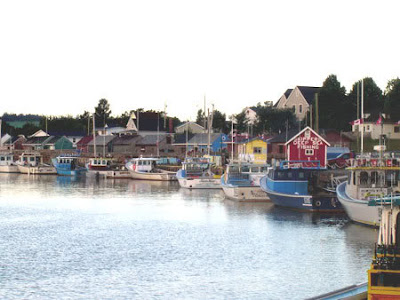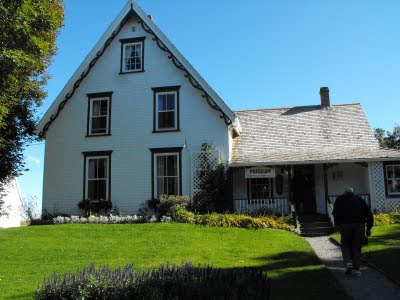Prince Edward Island "Canadian Greenest Province"

Prince Edward Island is Canada's smallest and greenest province. Cradled on the waves of the Gulf of St. Lawrence, PEI is known for the vivid colours of its gently rolling landscape. Prince Edward Island is surrounded by miles of sandy beaches and red sandstone cliffs and is sized just right for touring.
Blue Heron Drive

Blue Heron Drive (about 200 km / 124 mi), in the central part of the island, has as its main attraction the long silvery beaches of the North Shore - the best are in Prince Edward Island National Park (entrance fee only if by car). The drive passes through many little holiday resorts and many of the island's tourist attractions and leisure parks, the most interesting being places connected with that famous book "Anne of Green Gables".
From Charlottetown Blue Heron Drive follows the North Shore, with its fine beaches and red sandstone cliffs, then at New London Bay, further west, it comes to the home of the blue heron after which it is named (the sign is a blue heron on a blue-framed square white background). From here it turns south to the South Shore, with several Provincial Parks and their beaches, campsites and picnic areas, ending up back at Charlottetown.
Cavendish

Cavendish has one of Canada's most popular beaches. Its Rainbow Valley amusement park of about 9 ha (22 acres) has pleasant gardens, a boating lake and a barn.
The biggest attraction around Cavendish is the Avonlea Village of Anne of Green Gables.
Sandspit Cavendish Beach

Sandspit Cavendish Beach has 18 rides and attractions for all ages including a rollercoaster, go-karts, classic family rides, a miniature golf course and rides geared to children.
Green Gables Farmhouse

The countryside around Cavendish was the setting for Avonlea, Lucy Maud Montgomery's fictional farming community of her famous novel "Anne of Green Gables". The Green Gables Farmhouse, about 2 km (1 mi.) west of the town on Highway 6 near the Cavendish entrance to the national park, is an enduring reminder of this popular children's classic.
Ann of Green Gables Museum

The "Anne of Green Gables Museum" in Kensington is in the house built in 1872 where Lucy Maud Montgomery lived from time to time, and is packed with Montgomery memorabilia including signed copies of the first edition of the famous novel.
Malpeque

Malpeque is one of Prince Edward Island's historic sites. A home to the Micmac, it was settled by the French in the early 18th c. Captain Samuel Holland, sent here by the British in 1765, named the place "Princeton", but it later reverted to its old Indian name. Much of the later immigration was from Scotland, and many of their descendants still live here today.
Malpeque Gardens

One of the finest gardens in eastern Canada, Malpeque has several hundreds of different kinds of flowers, including dahlias and roses, and contains such interesting features as an old windmill and a showcase beehive.
Port-la-Joye-Fort Amherst National Historic Site

Port de la Joie, was the first place on the island to be settled by the French in 1720. The British built Fort Amherst here in 1758 after they captured the settlement, but today only the earthworks remain. The whole site has been declared the Port-la-Joye-Fort Amherst National Historic Site of Canada.
Green Provincial Park

The road to Green Provincial Park winds its way through woodland groves and open fields. At the center of the park is the elegant villa of shipbuilding magnate James Yeo Jr. Built in 1865, the villa has been restored and filled with period furniture. The history of shipbuilding on Prince Edward Island is told in a modern exhibition building and a 19th c. shipyard at the water's edge shows how a wooden ship was built. The park has what are probably the finest campsites on the island.
Lady Slipper Drive

Named after the Lady Slipper orchid, Prince Edward Island's floral emblem which grows in its shady woodland, the drive is signed by a red orchid in a red frame on a square white background. Lady Slipper Drive (about 300 km (186 mi.)) follows the coastline in the western part of the island, with its red sandstone cliffs, silvery sands and lush green meadows, passing through peaceful farmland growing mostly potatoes.
This part of Prince County has lots of little villages, many of them quite old and still following a traditional way of life. Here live the descendants of the French-speaking Acadians who since 1884 have had their own flag as a symbol of their cultural unity.
Acadian Pioneer Village

The Acadian Pioneer Village at Cape Egmont, 5 km (3 mi.) west of Mont Carmel on the Acadian Shore, is a recreation of an authentic early 19th c. village, with a church, village hall, store, school, a well and smithy. The houses have objets d'art and restored furniture of the period.
Cedar Dunes Provincial Park

North along the coast, at the island's westernmost point, the 2 km (1 mi.) white-sand beach of Cedar Dunes Provincial Park is overlooked by the West Point Lighthouse, an old wooden lighthouse from 1874 that had its own keeper until thirty years ago. It was restored and now contains a little museum a shop for craftwork and rooms for visitors.
Malpeque Bay

Malpeque Bay is where Prince Edward Island's world-famous oysters have their main beds. It is the center of Canada's oyster-farming, yielding about 5 million oysters a year. In the west of Malpeque Bay numerous branches of the fishing industry have their bases.
Prince Edward Island National Park

Take Highway 25 out of York, then turn right onto Highway 220 to Grand Tracadie, then left to Prince Edward Island National Park. This extends from Tracadie Bay in the east to Cavendish Bay in the west, a long line of lovely white-sand beaches. Over 200 species of birds can be seen here, including the superb blue heron. Despite the enormous influx of tourists in summer, the park has surprisingly managed to maintain its ecological balance.
The landscape of Prince Edward Island National Park includes sand dunes, beaches, cliffs, forests, and wetlands. Although it is most visited during the summer months, the park is also open in winter and offers cross country ski trails.
Wood Islands

Wood Islands, on the south coast, has a ferry terminal with ferries to Caribou, Nova Scotia.
No comments:
Post a Comment